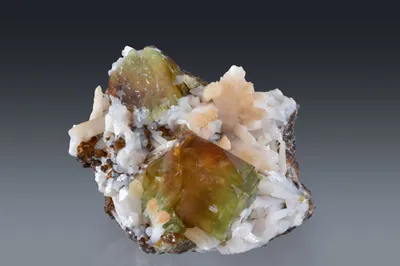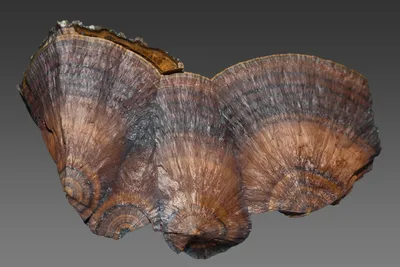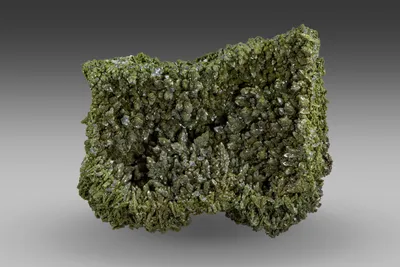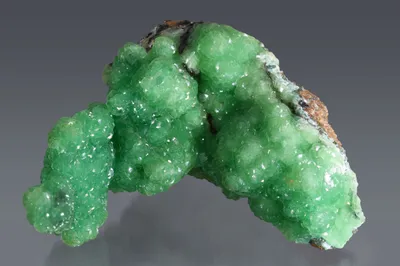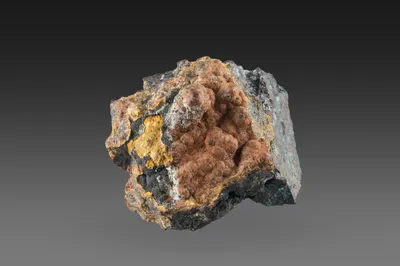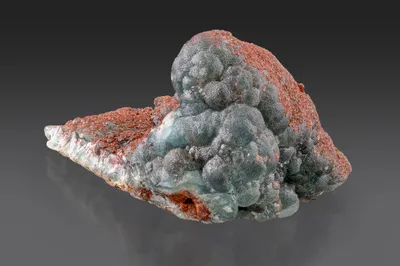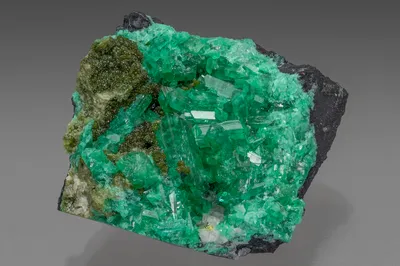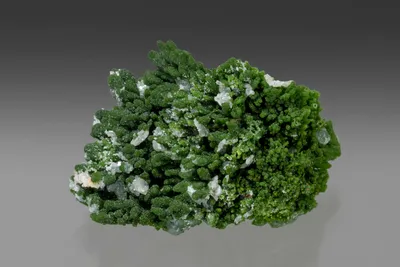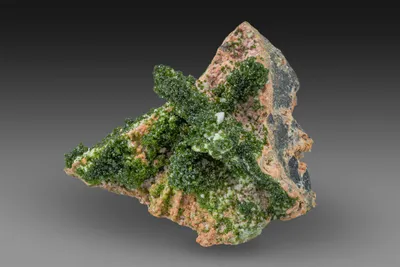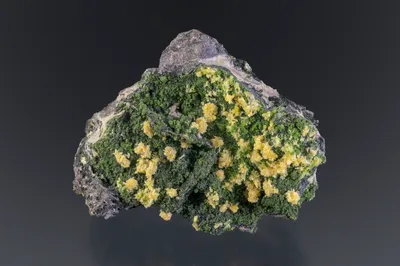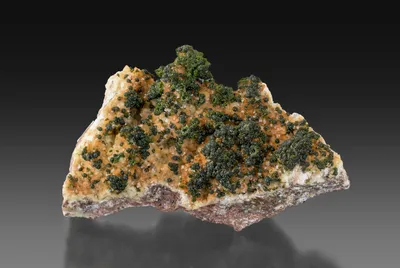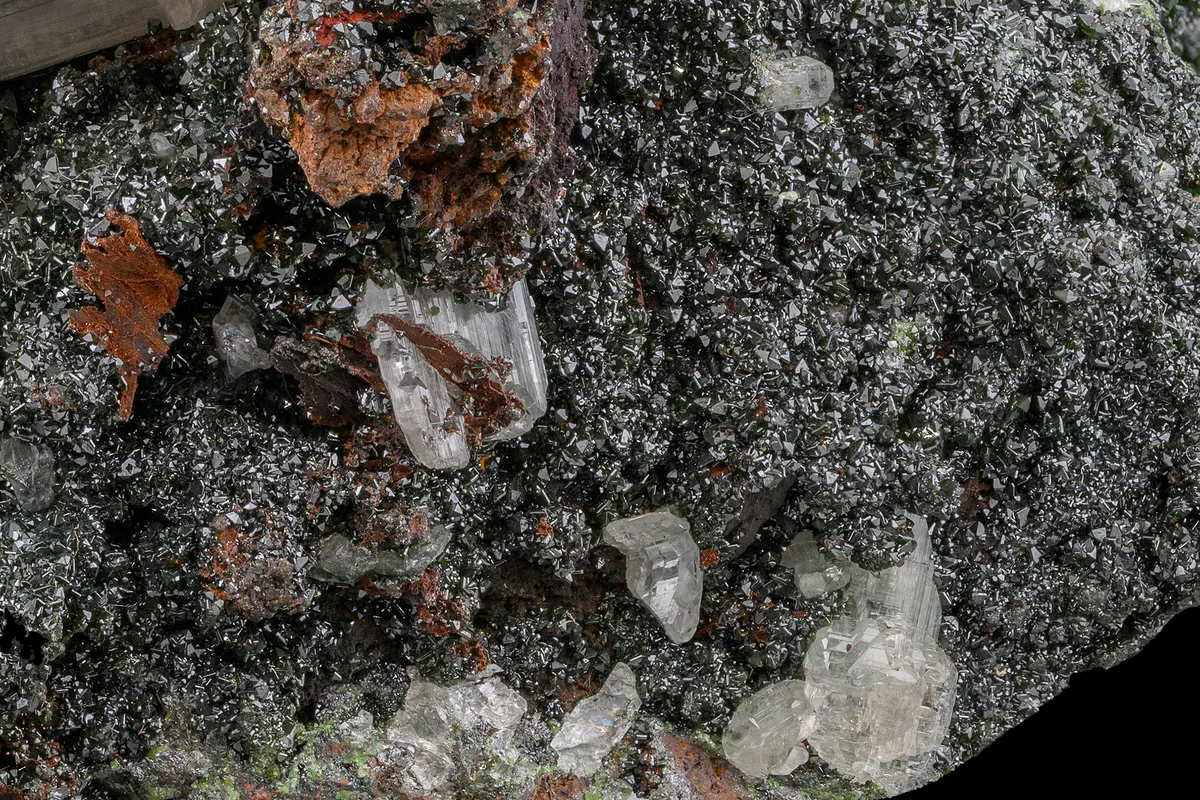
Image Credit: Malcolm Southwood
Title
duftite
Composition
PbCu(AsO4)(OH)
Crystal System
Orthorhombic
Status at Tsumeb
Confirmed
Abundance
Very common
Distribution
First, second and third oxidation zones.
Paragenesis
Supergene.
Type Locality
Yes
Entry Type
Species TSNB111
Type Mineralogy
A new arsenate of lead and copper was described by Pufahl (1920), who was studying material collected at Tsumeb in (or perhaps before) 1911. He noted mammillary crusts of an olive-green mineral which lacked measurable crystals but which, on analysis, gave a stoichiometry quite different from bayldonite or olivenite, which the new mineral resembled. He proposed the name duftite for his new mineral, honouring G. Duft, a director of OMEG who had done much to encourage and promote scientific research in South West Africa. Gebhard (1999) pointed out that the same mineral was analysed and provisionally named "parabayldonite" by Biehl (1919), although Biehl’s doctoral thesis (to which this citation refers) was never formally published and therefore not widely read.
General Notes
Duftite occurs as olive to grey-green and dark-green crusts, sometimes sub-botryoidal. Also as distinct green crystals exceptionally to 3 mm (Pinch and Wilson, 1977), and typically with curved, saddle-shaped faces (Keller 1984). Duftite is readily confused with conichalcite (with which it effectively forms a continuous series), and may also closely resemble mottramite, bayldonite or arsentsumebite.
Duftite seldom forms aesthetic specimens in its own right but commonly occurs as an accessory mineral providing attractive colour contrasts with other species.
Gebhard (1999) notes that the finest duftite known came from the third oxidation zone. He notes three occurrences in particular:
- Sprays of blackish-green prismatic crystals (to 5 mm) on quartz.
- Elongated crystals of olive-green duftite associated with adamite from 43 Level.
- Blocky crystals (to 2 mm) with malachite, also from 43 Level.
Guillemin (1956) proposed that compositions close to end member duftite – PbCu(AsO4)(OH) – are isostructural with descloizite. He called duftite of this composition α-duftite and found that it could readily be synthesised in the laboratory. However, he also found that certain duftites with more than about 20% substitution of calcium for lead were isomorphous with conichalcite and could not be synthesised. He proposed the name β-duftite for these compositions and suggested that β-duftite forms a series with conichalcite.
According to Von Bezing et al. (2014) duftite from the upper portion of the first oxidation zone is usually lead-dominant (the former duftite-α), while second oxidation zone duftite is usually calcium-bearing (the former duftite-β). The distinction between these putative "polymorphs" was quite important at Tsumeb in the 1970s and 1980s, because they accounted for a significant proportion of the lead (and to a smaller extent copper) in certain ore types but responded quite differently to the flotation process in the concentrator. Because of this, former Tsumeb Corporation mineralogist John Innes encouraged various technical and academic studies of these minerals. The "duftite problem" has been discussed by several authors, but the most relevant to a simple explanation are as follows:
Jambor et al. (1980) examined a series of calcian duftite and plumbian conichalcite specimens from Tsumeb and concluded that complete solid solution probably exists between the duftite and conichalcite. They proposed that β-duftite is merely an intermediate in the duftite-conichalcite series (as opposed to a distinct polymorph).
Kharisun et al. (1998) studied the structure of duftite, conichalcite and of intermediate compositions. They agreed with Jambor et al. (1980) that β-duftite is not a distinct mineral but rather a composition, or series of compositions within the duftite-conichalcite series. However, the relationship is not one of simple solid solution; instead, modulated structures comprising domains of different composition occur. This explains why Guillemin (1956) had been unable to synthesise his beta polymorph, but it also indicates that β-duftite is not a valid mineral species.
Burke (2006) included duftite-beta in a list of minerals officially discredited by the IMA.
Keller (1977a) included duftite in no less than seven of his Type I parageneses (i.e., sequences forming at near-neutral pH values). These parageneses are:
I/1: goethite >> duftite (i) >> cerussite >> duftite (ii) >> dolomite.
I/3: cerussite >> [duftite (i) + malachite] >> mimetite >> duftite (ii) + malachite >> cerussite
I/5: [hematite + goethite] >> wulfenite (i) >> duftite >> calcite >> wulfenite (ii)
I/6: [willemite (i) + smithsonite] >> [rosasite + duftite] or mimetite >> willemite (ii) >> cerussite >> smithsonite.
I/7: duftite >> dundasite >> cerussite >> azurite >> malachite (after azurite).
I/8: quartz >> mottramite >> olivenite (i) and (ii) >> duftite >> malachite >> azurite >> malachite (after azurite).
I/9: dolomite >> duftite >> plancheite >> dioptase (i) >> dioptase (ii).
Keller (1984) considered that duftite occurred only between depths of 50 and 100 m in the upper portion of the first oxidation zone, and again in the third oxidation zone, when in fact the mineral was significantly present in all three oxidation zones.
Cairncross (2019) described pseudomorphs of duftite after wulfenite.
Associated Minerals
adamite; anglesite; aragonite; arsentsumebite; azurite; bayldonite; beudantite; calcite; cerussite; chrysocolla; conichalcite; copper; coronadite; cuprite; descloizite; dioptase; dolomite; dundasite; elyite (?); gartrellite; goethite; gypsum; hematite; hydrocerussite; jamesite; maghemite; malachite; mimetite; minrecordite; molybdofornacite; mottramite; ojuelaite (?); olivenite; oxyplumbomoréite; plancheite; quartz; rosasite; segnitite; smithsonite; tennantite-(Zn); tsumcorite; willemite; wulfenite; zincgartrellite; zincolivenite
Pseudomorphs
Duftite is reported to form pseudomorphs after the following minerals: azurite (rare); dolomite (rare); enargite (rare); mimetite(rare); tennantite (rare); wulfenite (rare).

